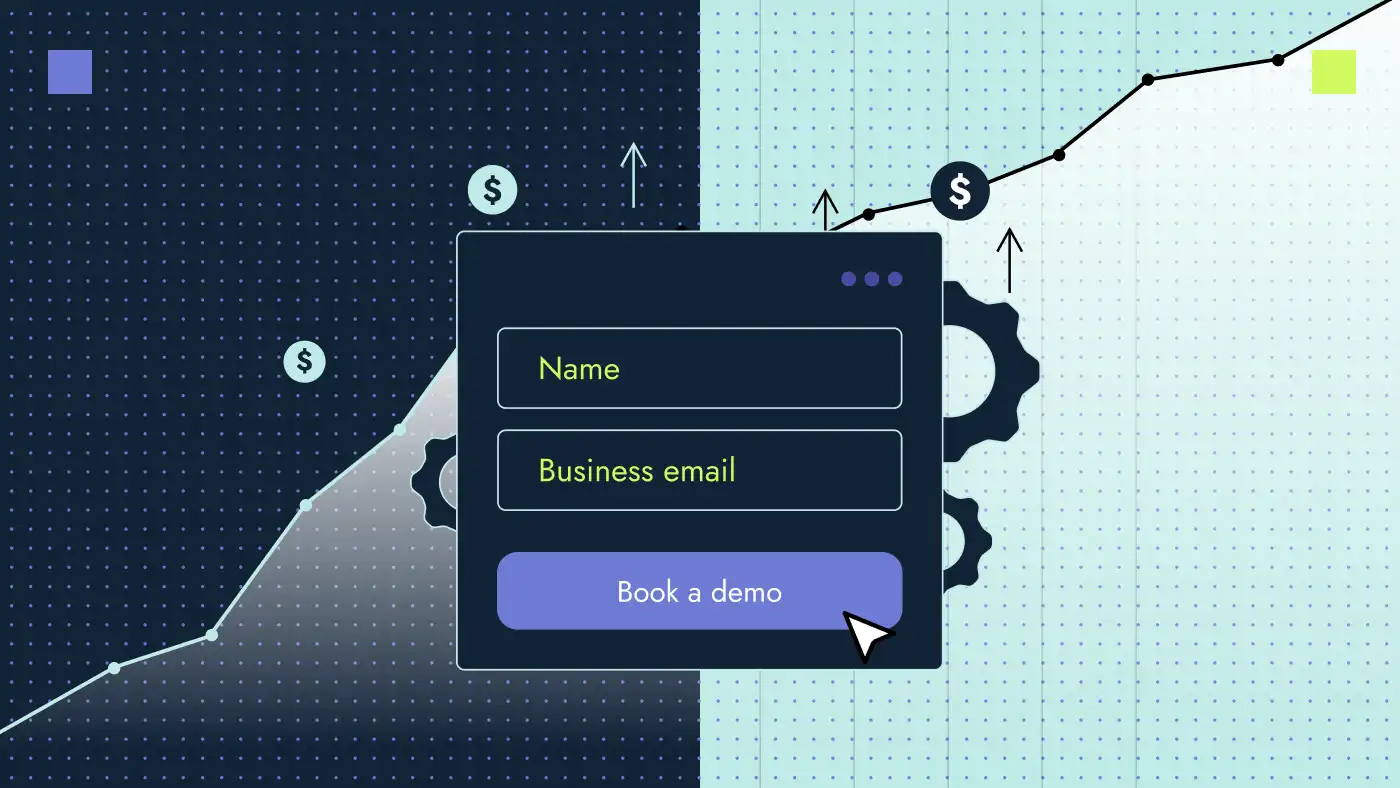B2B messaging framework: A storytelling guide for SaaS startups

Anna Gladkaya
Chief Operating Officer (COO)

Story, characters, conflict, plot twist, resolution – it may seem like we’re laying out the basic elements of a movie script; and in fact, we are. Yet, these are also key points in business storytelling, a practice that helps your startup build engaging messages for target audiences.
However, what your potential customers may not yet know – as sometimes happens with people watching movies – is how the hero (your business) will solve the conflict (the customer’s need).
If your SaaS startup seeks powerful storytelling to capture audience attention and a strong plot twist to reveal your solutions, you need a B2B messaging framework.
What is a B2B messaging framework?
A B2B messaging framework is a narrative structure that defines your B2B company’s brand identity, guiding how you communicate your value proposition, product offerings and key messages to potential customers.
Imagine a blueprint containing:
- The essential statements about your startup (what you are)
- The main features of your products or services (what you do and how)
- Your target audience (who is it for)
- The reasons why customers should choose your offerings over those of competitors

| Mission | Vision | Values |
|---|---|---|
| Company's purpose and what it does to achieve it. | Company's goals and desired future state. | Core beliefs and priorities that shape the company's culture. |
Why B2B messaging is critical for startup success
As the foundation for your all marketing efforts, B2B messaging contributes to a consistent narrative across business departments and audiences.
Let’s say your startup is launching a campaign to promote your latest SaaS product. You have aligned the key features and benefits with the product team and now need to update the website, run an SEO program and share cohesive storytelling with your personas across your marketing channels.
Without setting a key message, your campaign would be out of sync in its touchpoints, probably resulting in rework, underperformance and huge financial waste. That’s why B2B messaging is so critical for your startup’s success.
Top reasons to build a brand messaging framework
1. Establish a clear value proposition
Your value proposition communicates how your SaaS product solves specific problems and fulfills other businesses’ needs. It establishes a strong reason for potential clients to engage.
Let’s compare the value propositions of two project management platforms: Asana and ClickUp. Both competitors focus on convenience and versatility but make different claims.
Asana vs ClickUp value proposition

2. Build awareness and improve brand perception
Well-crafted messaging helps to position your company as an expert in the field, nurture trust among stakeholders and improve brand perception.
Let’s consider the example of the content management system (CMS) Webflow, which explores its brand concept – “The site you want, without the dev time” – through various marketing channels:
- YouTube channel: Sharing video tutorials teaching how to use the platform
- Webflow Forum: A Q&A community where users exchange experiences
- Webflow University: A platform offering free web design courses and training
In all of these initiatives, Webflow reinforces the perception of a brand with an educational purpose, creating content in many formats and facilitating access for users to develop their professional skills.
3. Differentiate solutions in a competitive niche
How is your startup differentiating itself from established players? A strong messaging strategy emphasizes how your product’s key attributes, approaches or innovations outclass the competition.
If your SaaS startup is in the early stages, you can adopt a messaging framework that highlights advantages that may pose challenges for larger players:
- Agility and speed: Early-stage startups are able to adapt and innovate fast, enabling them to respond to evolving customer needs and market dynamics more swiftly.
- Personalized customer service: Startups can offer a more personal approach, building stronger relationships with customers than larger competitors.
- Integrations and partnerships: Forming strategic partnerships with other startups or services and integrating your product with established platforms helps increase your reach and credibility.
- Freemium access: Offering a model where potential customers use your product for free with the option to upgrade helps to build a user base and prove the value of your SaaS solution.
If you want to position your startup in a competitive niche, make sure to leverage your competitor matrix as an aid to create your messaging framework.
Competitor comparison helps you to:
- Easily identify competitive advantages
- Address specific market gaps
- Better understanding of customer pain points
- Define a unique value proposition
- Adapt to market trends
- Target underserved audiences
- Optimize pricing strategies
Need help comparing your SaaS with rivals? Outline your strengths and differentiators with our competitive matrix template.
4. Guide sales and marketing efforts
A well-defined B2B messaging framework helps your sales and marketing departments, including customer service agents, to deliver messages addressing your personas’ specific needs in various channels.
In 2023, customers preferred digital channels over conventional sales meetings and had high expectations of personalized experiences before making purchases from B2B companies – as indicated by research from Insider Intelligence. These behaviors indicate that businesses must communicate in a way that engages, interacts and offers solutions to customers clearly and persuasively.
Considering this challenge, what qualities does a messaging framework need to drive results? See the reference table below:
| Messaging qualities | How to implement them in your framework |
|---|---|
| Clarity | Verify if your messaging is easily understood. Test with customers and employees in different channels and work on improvements if necessary. |
| Relevance | Confirm that your messaging is aligned with your personas' needs and current industry trends. |
| Value generation | Ensure that your messaging is solving a potential customer's problem. Remember to emphasize the benefits they gain from choosing your solution. |
| Differentiation | Stress specific product benefits, features or technology that position your offering in the market. |
| Brand personality | Maintain a consistent tone of voice that expresses your brand's personality and values. |
Setting the company’s point of view (POV)
To create a successful messaging framework for your SaaS startup, you must set the company’s perspective on industry trends, market challenges and tailored solutions for specific buyer personas.
You need a document that provides a deeper understanding of your business’s unique insights, stances and approaches: your point of view (POV).
With a POV document, your B2B company structures its viewpoint clearly through messaging and content marketing that reinforces how your value proposition fulfills a gap in the market.
Here are the main elements of a POV document.

An example of communication with a clear point of view is Box.com, an enterprise solution for the storage and management of documents in the cloud. Their purpose of simplifying work is spread across the company’s website, presented clearly and objectively, making the reader’s life easier.
How to apply your POV in your marketing initiatives
Here’s how to communicate your business POV through your B2B marketing efforts:
1. Incorporate your POV into your branding efforts
Companies with strong branding show a 74% higher return on their brand marketing investment and hold a 46% larger market share than less developed brands, according to a BCG survey. In B2B marketing, storytelling serves as a branding tool, employed to build attractive and memorable narratives that enhance the customer experience.
You can incorporate your startup’s POV into your branding initiatives, for example, by creating a tagline — a short phrase that works as a brand statement, synthesizing your value proposition.
Here’s an example from CivicPlus, which offers technology solutions for governments. The tagline “Powering and empowering government” highlights their value proposition, as a company that not only provides software that powers government operations but also empowers governments with technology to better serve their residents.

2. Create brand awareness campaigns
You can communicate your business POV through targeted brand awareness campaigns.
The communication platform Slack, for example, launched a brand activation campaign during the 2023 SXSW conference.

Here are my recommendations to amplify a brand message through awareness campaigns:
- Use impactful design, well-written texts and audio resources to create a compelling story
- Leverage intent data and SEO to create a connection with targets’ preferences and interests
- Integrate different channels, such as website, blog, e-mail and social media
- Create segmented ads to amplify visibility between specific audiences
- Ensure the message is consistent across all touchpoints
- Work in partnership with other brands, influencers or organizations
- Promote your campaign through events to encourage interaction
By strategically placing your brand in front of your buyer personas, you enhance visibility while establishing a strong association between your POV and your brand identity.
3. Encourage customer engagement
A challenge that your marketing team may face when applying business POV in their strategy is the lack of audience engagement with the message. Even if your B2B messaging framework is well aligned with the customer’s needs, it still needs to be attractive to generate engagement.
An example of storytelling with a unique point of view was made by the e-mail marketing platform Mailchimp. Seeking to untangle “clustomers” into “customers,” this campaign promotes their advanced segmentation and personalization capabilities — the company’s solution to not treat customers like a cluster of customers or “clustomers.” This funny approach — resonating with the brand’s playful personality — is engaging.
Components that contribute to an engaging business story include:
- Data-driven themes: Based on customers’ interests and needs
- Compelling characters: Key figures within the company, such as founders or customers
- Plot structure: Elements such as challenges, opportunities or innovations
- Resolution: How your startup provides solutions and positive outcomes
- Emotional resonance: Real successful stories, testimonials, case studies
- Visual appeal: Consistent visual guidelines everywhere, from campaigns to presentations
- Well-crafted writing: Compelling copy and authentic language as a standard
- Immersive experiences: Visual and text-to-speech features as brand resources
🏆 And the prize of the best story goes to… businesses that measure their narrative engagement. By analyzing your campaign performances, your startup refines content, aligns it with your goals and builds stronger connections with your buyer personas.
4. Consider customers’ POV in your B2B marketing strategy
A customer’s point of view is the perspective, opinions and perceptions of an individual customer regarding a product or service. It includes their expectations, experiences and feelings based on interactions with the company along the customer journey.
If you want to make sure the target audience is interested in your SaaS startup’s messaging, align it with a customer’s POV. It helps your startup build a customer-centric approach.
Here’s an example from Vanilla, an estate planning software for financial advisors. On Vanilla’s website, there are personalized solutions from two customer’s points of view: advisors and state planners.


Download: Free template to build your ICP
5. Output content that resonates with your customers
Research by Demand Gen Report reveals that 62% of respondents from B2B SaaS firms depend more on content today to connect with their audiences than ever before. To ensure that your messaging is aligned with customers’ POV, include in your marketing strategy content creation based on data, addressing specific pain points of the audience.
Don’t forget the importance of researching keywords that your customers are looking for – based on their specific POVs. Start by setting a foundational SEO practice. If you’re in a market full of larger players, an enterprise SEO program helps you communicate your differentials. If you’re innovating or establishing a new field, it helps you create demand and provide your potential customers with information about your offerings.
✏️ Check out our guides:
10 questions to guide your B2B brand messaging framework
Before you start crafting your B2B brand messaging framework and outputting SEO content that resonates with your audience, take these top 10 questions into account:
1. What’s happening in the market?
This is the starting point of your SaaS messaging framework. You need to describe the problem your startup wants to solve. Try to use simple language, as you were explaining the context to a customer.
2. Who cares about this problem?
Make sure your target audience cares about the problem your company is trying to solve. When setting your ideal customer profiles, pay attention to their concerns, challenges and frustrations.
3. What’s your value proposition?
What are the gaps in the market your startup is filling? Define your positioning statement, specifying how you’re solving a real problem as no other competitor is.
4. What do you want to be known for?
Your company’s vision and values must be expressed when answering this question. After all, this is your core message.
5. Why should a customer choose you?
It’s time to emphasize your differentiators, aligning them with your customers’ top pain points. Don’t forget to add your “plot twist”: it can be a strategic partnership, an innovative feature or approach, a leadership’s unique vision or another narrative element that makes your storytelling engaging.
6. What are your best product features? And your most competitive benefits?
Describe your primary and secondary product attributes as well as the key customer benefits they provide. Include proof points and examples that evidence these benefits – such as numbers or data that assure efficiency, productivity, time or cost savings, integration capabilities and more.
7. What are the other options available? And what are their limitations?
Discuss your competition, as it gives your customers a parameter to evaluate what is the best offering. Map your adversaries’ limitations in comparison to your SaaS solution.
8. How are you generating business value?
When your company articulates how it generates value, your messaging has a better chance of attracting customers, investors and partners, positioning itself against competitors.
9. In what ways are you facilitating your customer’ work throughout their journey with your SaaS product?
Take time to rethink your marketing efforts after developing your messaging framework. The implementation may include solutions like an onboarding experience, a FAQ, personalized assistance in your customer service channels and training, among other ways to facilitate the buyer journey.
10. What key performance indicators (KPIs) are you using to measure the success of your B2B messaging framework?
Don’t look only at sales KPIs, such as revenue or conversion rates. Instead, analyze various categories of metrics to verify the success of your messaging: from awareness, engagement and conversion KPIs to customer feedback, content performance and retention rates.
Now that you have an overview of the key elements to create a strong B2B messaging framework and measure its performance, it’s time to put your startup’s plan into action.
B2B messaging framework template
Here is our free B2B messaging framework template for SaaS startups.
| The market | Describe the problem your startup is trying to solve |
|---|---|
| Target audience | Ideal customer profile 1 Ideal customer profile 2 Ideal customer profile 3 |
| Objective | Include your mission and why you exist considering the market scenario |
| Overall narrative | Write your point of view or what takes you to this objective |
| Specific narrative | Explain what your startup wants to achieve, why and how it will get there |
| Value proposition | Syntethize your value proposition |
| Brand mission statement | Express your startup's brand mission in a short and impactful phrase |
| Product | Present your product |
| Main features | Feature 1 Feature 2 Feature 3 |
| Benefits | List the benefits of each feature |
| Supporting examples | Create examples for each feature to help sales, marketing, customer services and other teams to amplify the message |
| Elevator pitch | Include your startup elevator pitch, highlighting your differentials |
Let’s help you craft a powerful B2B SaaS messaging
As the B2B messaging framework examples in this guide show, powerful business storytelling is a tool to improve your brand perception, connect to your customers and generate sales.
If you need help finding your brand voice and communicating your point of view, get in touch with our team. From website rebranding to content writing, we’ve got you covered. Reach out now.

Anna Gladkaya
Anna Tymoshchuk is a seasoned business leader and strategist with over eight years of experience in B2B marketing and programmatic campaign management. She is currently serving as our Chief Operating Officer (COO), where she oversees operational improvement and project management at our company. She leads our PMO team and is committed to ensuring that all projects are delivered on time, within budget, and to the highest quality standards. Anna's expertise lies in designing and executing data-driven advertising campaigns and web builds that help businesses achieve their marketing goals. She has a deep understanding of the advertising ecosystem, and her ability to leverage data analytics to optimize campaigns has helped many clients achieve significant ROI. Anna's passion for continuous improvement and innovation is evident in her work. She is always looking for ways to streamline processes, reduce costs and improve the overall customer experience. Her ability to think outside the box and come up with creative solutions has helped our company stay ahead of the competition. Aside from her work, Anna is an avid foodie and loves starting her day with a latte and an almond croissant. Her colleagues often joke that her love for pastries fuels her energy to drive operational efficiencies and deliver exceptional results.





